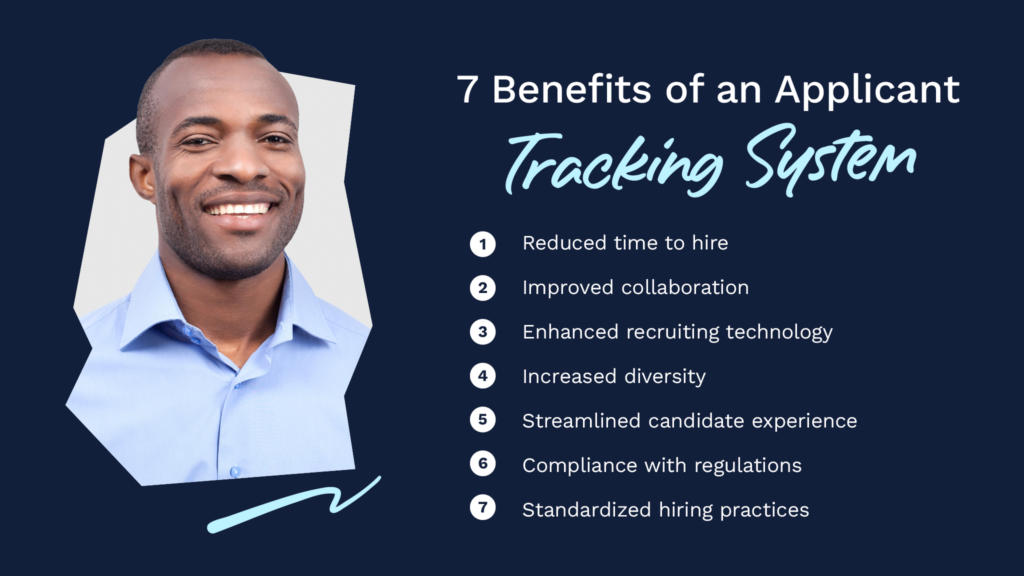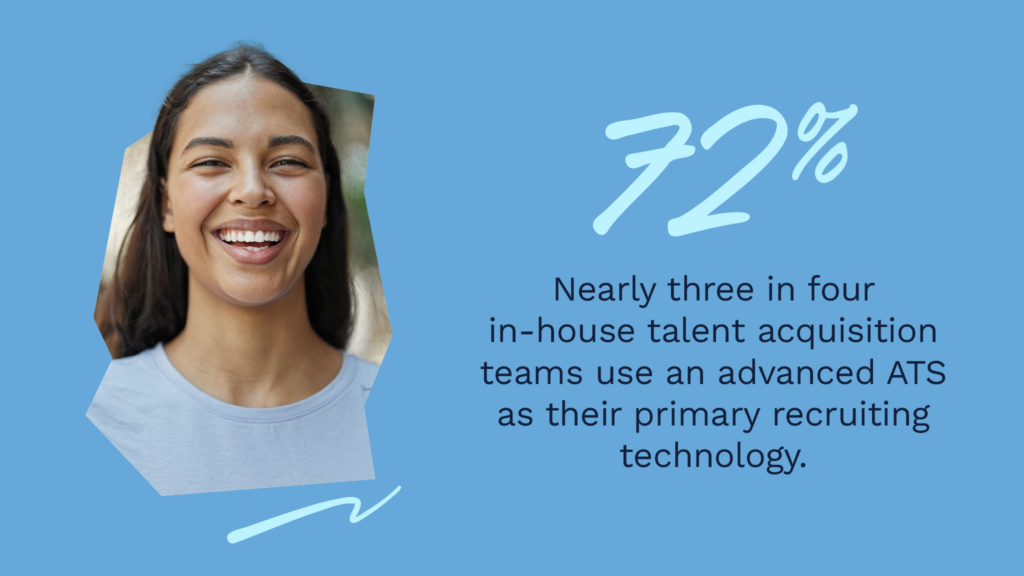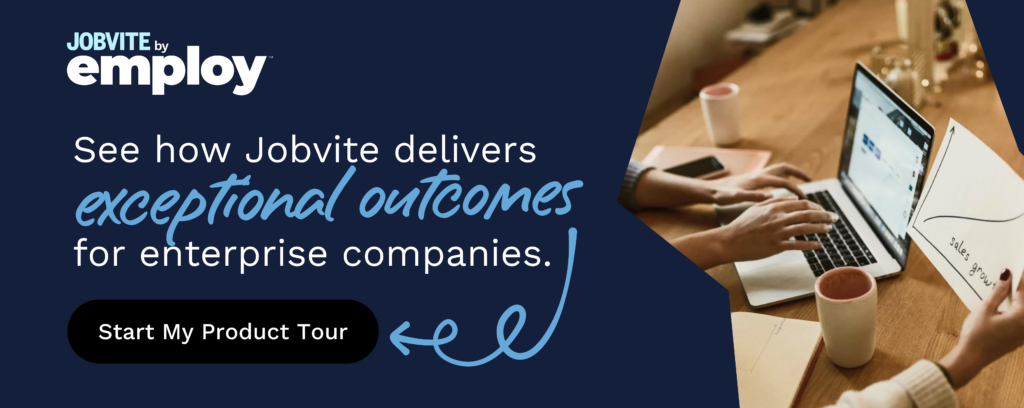Given your hiring team manages thousands of applicants each year, your company needs a robust applicant tracking system (ATS) in your HR tech stack to stay organized and achieve your hiring goals. In fact, over 95% of Fortune 500 companies currently use an ATS to manage and track applicants who apply to open positions.
While a traditional ATS is excellent for storing candidate details, the best applicant tracking systems today work in lockstep with other talent acquisition technology, including candidate relationship management systems (CRMs) to source top talent, centralize communication with prospective hires, and more efficiently engage, interview, and analyze applicants. Using a leading ATS system, recruiters can easily search resumes and filter candidate information, decreasing the time needed to manually source talent for open positions and ensuring they connect with the best people for each position.
If you and other hiring stakeholders at your organization are wondering how an ATS can streamline and improve your recruiting and hiring efforts, you’ve come to the right place. Let’s answer your most pressing questions in this FAQ guide.
- What is an ATS?
- What features should enterprises look for in an ATS?
- How does a top ATS work?
- What are the benefits of using an ATS?

What is an ATS?
An ATS helps companies organize candidates for hiring and recruitment purposes. These systems allow businesses of all sizes and across industries to collect candidate information, organize prospects based on experience and skill set, and filter applicants.
What features should enterprises look for in an ATS?
Not each ATS is created equally. Enterprises like yours need the most comprehensive technology available to handle the complexity and scope of your hiring efforts.
For example, a modern ATS simplifies the recruiting process for talent acquisition (TA) teams by using automation and AI to empower talent acquisition teams to identify, reach out to, interview, and advance qualified candidates efficiently. Since open positions can attract thousands of candidates regardless of whether they have the necessary work experience, education, and certifications, automation saves companies and recruiters time that would otherwise be spent manually weeding out these job applicants.
In addition to automation, look for an ATS that allows your company to achieve the following tasks:
- Post job openings on career sites and job boards
- Connect with candidates on social media (such as LinkedIn)
- Build relationships with interested candidates
- Assess employee referrals and internal talent
- Nurture job seekers through the recruiting funnel
- Schedule interviews with potential candidates
- Convert late-stage applicants into new hires
- Rediscover top talent or silver medalists
- Analyze real-time updates and make data-driven decisions

How does a top ATS work?
Every ATS is different, but here’s a high-level workflow that the top applicant tracking systems can achieve:
- Once the talent acquisition team has secured an adequate pool of applicants, they can then be tagged and labeled accordingly, based on resume information.
- From here, recruiters can sort through candidates by filtering based on skillsets and job descriptions published internally and externally to find strong-fit candidates for open roles.
- The ATS can then enable recruiters to communicate with candidates and schedule screening interviews and hiring team interviews.
- Hiring team members submit feedback immediately following interviews with applicants and add notes about each candidate. These scores and notes allow hiring decision makers to evaluate prospects in a bias-free manner and advance ideal applicants quickly.
Note that the process will look very different between enterprises using a modern versus traditional ATS. For instance, the best ATS software solutions use the latest technology, such as natural language processing, to scan resumes, provide recommendations on which candidates to reach out to for job openings, and locate passive talent that’s already in the ATS.
Plus, a top ATS integrates with both common and niche job boards, and offers universal, one-click job posting to easily publish listings for available positions.
What are the benefits of an ATS?
By investing in advanced ATS software for your talent acquisition team, your business can improve recruiting metrics, like talent pipeline efficiency, interview speed, overall hiring costs, and candidate quality.
Some other benefits your organization can experience with a top ATS include:

1. Reduced time to hire for critical roles
From the moment you pinpoint an optimal prospect for an open role to the time they sign and submit their job acceptance letter, you tackle a lot of vital talent acquisition tasks. Only with a leading ATS can you streamline those activities and ensure you steadily improve your hiring speed.
With Jobvite’s Evolve Talent Acquisition Suite, for instance, talent leaders and operations managers can get a holistic view of their entire team’s pipeline progress in real time and share insights with TA specialists. Meanwhile, each recruiter can see data tied to their recruitment activities to easily discern where each candidate is in their funnel and determine the next steps to take with each active opportunity.
2. Improved collaboration for your hiring team
It’s not just your talent acquisition efforts that benefit from an ATS. Hiring managers can also use them to ensure they have full visibility into how many applicants have applied for their roles, how many proactively sourced candidates recruiters have found, and where each of these individuals resides in the funnel.
As job seekers move from one interview stage to the next, hiring managers can easily compare candidates right in the ATS and extend offers to their preferred prospects.
3. Enhanced recruiting technology
Direct integrations to essential recruiting software and human resource information systems (HRIS) enable talent acquisition teams to sync data between their ATS and other hiring solutions.
This empowers a transparent end-to-end recruiting process, providing stakeholders a real-time, at-a-glance view of pipeline progress, and ensures critical candidate data is shared with business intelligence tools and HCM/HRIS systems.
Plus, these direct connections can speed up tasks across the recruiting funnel — from writing inclusive job descriptions and sharing automated interview updates internally to giving assessments to candidates and conducting background checks.
4. Increased diversity across your workforce
Diversity remains top of mind with many companies today — and for good reason. Studies show that the more diverse your workforce is, the more innovation and growth you’ll experience — with a 36% increased likelihood of outperforming competitors.
Having an ATS that makes it easy to connect with diverse talent, who are historically underrepresented, can become a competitive differentiator for your business. Look for solutions that have features like bias blocking so everyone has a fair shot at joining your company.

5. Streamlined candidate experience
An ATS can significantly improve the overall recruitment experience of both your hiring managers and candidates. For instance, an ATS:
- Supports speedy internal and external communication
- Provides channels for candidates to give feedback
- Automatically sends notifications and updates based on custom workflows
An improved hiring experience contributes to your employer brand, and an ATS is instrumental to make it happen.
6. Compliance with regulations
A critical aspect of the hiring process that can go overlooked is compliance with local, and, for larger businesses, international, hiring laws. For example, an ATS can keep records and help your organization quickly correct any discrepancies.
This is especially important for enterprise-sized organizations that hire hundreds if not thousands of employees per year. With that much recruitment data, information can easily slip through the cracks. However, an ATS, working in tandem with data-driven analytics, keeps all the insights you need — and discards the information you don’t, such as duplicate records — to ensure reporting accuracy and avoid penalties.
7. Standardized hiring practices
When it comes to hiring on a global scale, keeping only the most relevant and qualified candidates in your pool is crucial for efficient and effective hiring. That’s where having a standardized hiring practice can help. The right ATS can:
- Create custom workflow templates, so processes are consistent
- House data that’s used across the team, such as interview questions and follow-up timelines
- Assign team members to tasks and notify them automatically
- Collect and report on key performance metrics
- Integrate with onboarding systems to ensure applicants transition to new hires successfully
How to start using an ATS
Recruiting new talent for your business can be a major challenge and you want to be sure you invest in the right tools. Having an ATS can help simplify the hiring process and save recruiters and hiring managers a lot of time, stress, and energy — not to mention help your business grow effectively and efficiently.
Now that you know more about applicant tracking systems, take time to collaborate with other hiring and technology decision makers. Research the ATS marketplace and compare vendors — eventually, you’ll end up with a leading ATS that transforms your talent acquisition strategy for the better.
Find out how your business can benefit from using Jobvite’s ATS today.





